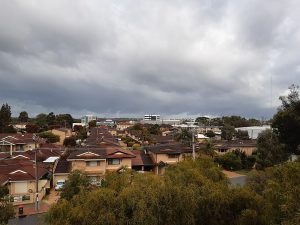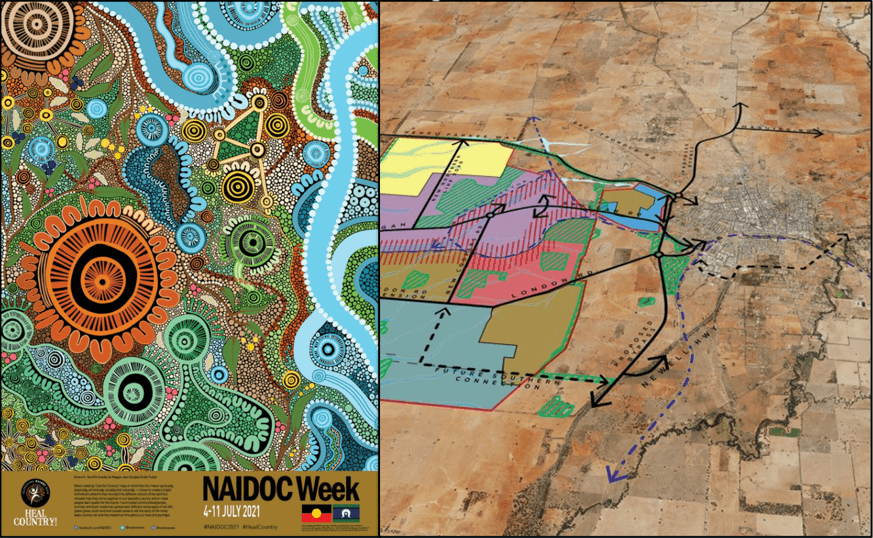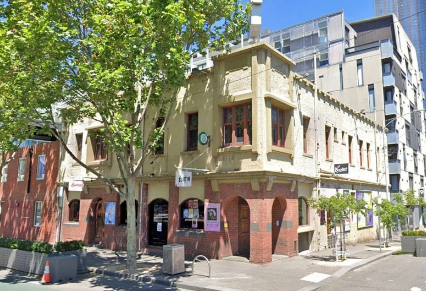Image credits:
- (Above). ‘Care for Country’ by Maggie-Jean Douglas – a Gubbi Gubbi artist from South East Queensland. The 2021 National NAIDOC Poster incorporating the Aboriginal Flag (licensed by WAM Clothing Pty Ltd) and the Torres Strait Islander Flag (licensed by the Torres Strait Island Council).
- (Right) Jensen Plus. Conceptual detail from the Parkes Special Activation Precinct Structure Plan.
I am pleased to share the fourth article in my ‘Sense of Place’ series. In this article, I discuss how ‘sense of place’ is often used in planning policy, but rarely defined or measured. In Australia, at least, we tend to focus on developing plans, rather than committing to — and funding — their implementation or evaluation. As a result, we continue to build unsustainable sprawl that offers no sense of place at all. Advocates for good governance and good development can use Liveability indicators to share detailed evidence of what is and isn’t working, and how to create change.
During this ‘Sense of Place’ series, I have discussed how frequently this term is used in our everyday language, yet rarely defined. I have flagged how research on ‘sense of place’ has identified four core components, namely: place attachment, place identity, place dependence and sense of community.
Not only is sense of place used to sell holidays and real estate: it is used to ‘sell’ policies. However, I have rarely seen official urban planning policies, strategies and plans define ‘sense of place’ in ways that enable its cognitive (identity), affective (attachment) or behavioural components to be teased out, let alone measured and evaluated. To illustrate, I offer three case studies from Victoria, Australia: (1) the State Planning Policy Framework; (2) Melbourne 2030, the 30-year metropolitan planning framework for Victoria’s capital city Melbourne, released in 2002; and (3) Plan Melbourne, the current 30-year plan released in 2014 and revised in 2017.
Case Study 1: State Planning Policy Framework
Victoria’s State Planning Policy Framework[1] (SPPF) is a key part of the Victorian planning system and the Victoria Planning Provisions. It sets the key policy direction for state planning issues, and to provide a ‘clear and consistent framework’ for land use decisions right down to the municipal level. It also makes numerous references to ‘sense of place’, without clearly defining it.
Sections 11 (Settlement) and 15 (Built environment and heritage) contain the bulk of references to sense of place. I have summarised mentions of ‘sense of place’ in the Attachment below.
From glancing that these mentions of ‘sense of place’, one gains an immediate impression that the SPPF wants us to ‘have it all’. Section 11 argues that settlements can be ‘high-quality’ as well as be prosperous, sustainable and have ‘a strong identity and sense of place. We can keep growing both our population and our economy (sustainably, of course) and ‘develop settlements’ whilst somehow ‘preserving and protecting features of rural land and natural resources and features’ and ‘protecting and enhancing sense of place’ all through ‘balancing strategic objectives’. I am not aware that the Planning and Environment Act 1986 requires that people’s psychological relationships to place be documented and protected as part of any development application. Indeed, health and social impact assessments are not required. Privileging Indigenous sacred sites does not appear to be part of any economic development strategy predicated on ‘jobs and growth’.
Case Study 2: Melbourne 2030
Melbourne’s first metropolitan plan was developed in 1929. However, it was never implemented. It was not until 1954 that the first metropolitan planning scheme was gazetted. Since then, more than 21 policies or plans have been developed[2].
 Melbourne’s sixth major urban planning framework, Melbourne 2030, was released in 2002[3]. By committing to better planning decisions and careful management, it promised a range of outcomes including a greener, more compact city; better management of metropolitan growth; a fairer city and a great place to be.
Melbourne’s sixth major urban planning framework, Melbourne 2030, was released in 2002[3]. By committing to better planning decisions and careful management, it promised a range of outcomes including a greener, more compact city; better management of metropolitan growth; a fairer city and a great place to be.
(At that time, “Victoria: the place to be” became the slogan on Victoria’s cars’ licence plates. I was always struck how the term worked at both an existential and aspirational level. It was a great example of cross-promotional corporate-government branding.)
For Melbourne 2030, I was invited to contribute to what become Direction 5, “A great place to be”. Direction 5 committed in part to promote good urban design to make the environment more liveable and attractive (Policy 5.1); and recognise and protect cultural identity, neighbourhood character and sense of place (Policy 5.2).
Melbourne 2030 was generated through highly participatory planning exercise that drew on the ideas of thousands of citizens. I was proud to have contributed to a smart, creative framework which, in Direction 5.2, promised to:
- Research the relationship between sense of place, urban character, landscape character and neighbourhood character as a basis for improvements to the planning system.
- Strengthen tools in the planning system to ensure development responds to its context in terms of built form, landscape character and cultural identity.
- Engage local government to undertake cultural planning to encourage and support local cultural activity and identity (p. 95).
Case Study 3: Plan Melbourne
Plan Melbourne 2017-2050 is the current urban planning framework for metropolitan Melbourne. Following the demise of the Labor administration, Plan Melbourne was developed by the incoming neoliberal Liberal government which rejected Melbourne 2030. Identified outcome areas for Plan Melbourne include the intention that ‘Melbourne is a distinctive and liveable city with quality design and amenity’; and that ‘Melbourne is a city of inclusive, vibrant and healthy neighbourhoods’.
For the first iteration of Plan Melbourne, Prof Billie Giles-Corti and I helped to write a chapter, ‘Liveable Neighbourhoods’ for the then Liberal government administration. During this period, the Liberal government led a contentious proposal for a major, $6 billion cross-city road tunnel, “East-West Link” that led to the resignation of five of the six members of Plan Melbourne’s Ministerial Advisory Committee (including the esteemed Chair, Prof Roz Hansen), who advised that they no longer wanted to be associated with it.
 Following the Labor Party’s return to power in 2014, rather than jettisoning Plan Melbourne, a ‘refreshed’ version was released in 2107. The concept of ‘20-minute neighbourhoods’, which Prof Giles-Corti had introduced to the first iteration, was retained. It gathered widespread diffusion as a metaphor for healthy, liveable neighbourhoods.
Following the Labor Party’s return to power in 2014, rather than jettisoning Plan Melbourne, a ‘refreshed’ version was released in 2107. The concept of ‘20-minute neighbourhoods’, which Prof Giles-Corti had introduced to the first iteration, was retained. It gathered widespread diffusion as a metaphor for healthy, liveable neighbourhoods.
‘Sense of place’ is mentioned four times in Plan Melbourne 2017-2050. The first two mentions appear in the introduction to Outcome 4: Melbourne is a distinctive and liveable city with quality design and amenity. Drawing on the State Planning Policy Framework parameters, Plan Melbourne identifies an inherent challenge of designing “a version of the city and state that, while protecting the best aspects of the natural and built environment, supports social and cultural diversity and economic activity and creates a sense of place” (p. 78). Some of the vagueness of definition is listed below.
- Plan Melbourne argues that sense of place is about characteristics and quality (“visual, cultural, environmental and social”), then about high-GDP communities experiencing ‘attachment to their cities’.
- Plan Melbourne refers to ‘place-making’ as “a conscious strategy designed to promote people’s health, happiness, prosperity and wellbeing” before noting that it “can apply to whole regions or individual neighbourhoods. In all cases it aims to capitalise on local assets, inspiration and potential”. Note that local features and landmarks are referred to as ‘assets’
- Policy 4.1.2, Integrate place-making practices into roadspace management, argues briefly that balancing ‘the competing demands of movement and place’ in street design can ‘help create a sense of place and structure across the city’ (p. 81).
- A 20-minute neighbourhood can create a more cohesive and inclusive community with a vibrant local economy—reducing social exclusion, improving health and wellbeing, promoting a sense of place, reducing travel costs and traffic congestion, and reducing carbon emissions across the city as a whole (p. 99). Actions 75 and 75.1 from the Plan Melbourne Implementation Strategy identify the need to “identify and undertake flagship 20-minute neighbourhood projects”, “provide guidance to local government on embedding the 20-minute neighbourhood concept into local planning schemes”, “build community partnerships to help deliver 20-minute neighbourhoods”, and “work across government to implement recommendations”
- Under the section, ‘Delivering strong leadership to shape the city’ (p. 136), Plan Melbourne notes that a monitoring and reporting framework has been developed to track the progress of the implementation of Plan Melbourne. Action 76 of Plan Melbourne’s Implementation Strategy[4] refers to Create a metropolitan-wide ‘neighbourhoods index’ that identifies the key characteristics of Melbourne’s neighbourhoods (such as activity centres, schools, public transport, housing density and diversity, walkability and tree cover). RMIT’s Australian Urban Observatory is well-positioned to deliver these liveability metrics. However, changes to people’s sense of place (or attachment, identity or dependence) have yet to be tracked.
- Drawing on the State Planning Policy Framework parameters, Plan Melbourne identifies an inherent challenge of designing “a version of the city and state that, while protecting the best aspects of the natural and built environment, supports social and cultural diversity and economic activity and creates a sense of place” (p. 78).
Reflections
Reading Melbourne 2030 after many years, the commitments of Direction 1, A more compact city and Direction 2, Better management of metropolitan growth make me wince:
For development within growth areas, new design standards based on the Neighbourhood Principles (see Direction 5, A great place to be) will create communities rather than subdivisions. Giving long-term certainty about growth areas is important as this will minimise speculative pressures on land values in nearby urban areas and help retain productive rural use. The location of growth areas reflects past policies and expectations, makes best use of existing public transport and major road infrastructure, and takes account of areas of special resource, environmental and landscape significance (p. 34).
Before the ink was long-dry on Melbourne 2030, the then Labor government allowed the urban growth boundary to be extended, twice, into agricultural land and green-wedge land on which developers had been speculating through concerted ‘land-banking’ on the other side of the urban growth boundary.
Following the release of the next 30-year plan, Plan Melbourne (2014; 2017), the urban growth boundary was further extended. In 2017, The Age reported in the social dystopia unfolding in the sprawling, underserviced new dormitory suburbs at the edge of Melbourne. Are Melbourne’s sprawling outer suburbs destined to become ghettos? (I will discuss this in-depth in a separate article.)
Plan Melbourne is predicated on a world view in which urban development is driven by developers in a laissez-faire, free-market economy, with the ‘guidance’ and ‘encouragement’ of a benevolent government. (Developers are still permitted to make significant financial contributions to each of the main political parties.) Reading the introduction to Plan Melbourne 2017-2050 now, it is striking to read the inherent contradictions built into its DNA: namely that population growth is core to delivering liveable and sustainable outcomes (including, apparently, ‘sense of place’), whilst reining in urban sprawl:
Population growth will give us the critical mass of people and skills we need to build better infrastructure for our cities, suburbs and towns… We need to see this population boom as an opportunity for Victoria to grow more liveable, more sustainable and more prosperous… For that to happen, we need to grow in controlled ways. That means stopping Melbourne’s urban sprawl, ensuring our regional cities remain affordable and liveable, making smart investments in infrastructure that encourage job growth outside the CBD, and giving local communities across the state support to put together their own plans for development. (Minister for Planning’s foreword, p. 1)
As outlined in painful, forensic detail in Melbourne: What Next? (2014), the fate of Melbourne 2030 is a case study of how Australia is great at planning, and woeful at implementing. Australia’s metropolitan plans (including Plan Melbourne) typically are full of vague aspirational language (i.e., development “could”, “should” or “ought to”). Yet our urban planning frameworks lack concrete, bipartisan, mandatory, funded implementation strategies that are achievable, measurable or defensible[5]:
Even before the Labour state government lost power in November 2010, Michael Buxton, a member of the Implementation Reference Committee for Melbourne 2030, was declaring that strategy “stone dead”… [W]ithout a genuine commitment to engaging with local governments, business, and civil society around conflicts and trade-offs, with no real implementation mechanisms such as funding key transport and infrastructure improvements or a solid urban growth boundary, and an absence of transparent monitoring mechanism, these strategic plans with a shared vision can easily be dismissed as tokenistic efforts, disguising ever more dependence on a market-based suburban sprawl approach to planning[6].
As Prof Billie Giles-Corti has warned, ultimately our planning policies are only as good as their implementation[7]. Piecemeal implementation, followed by yet more urban planning frameworks, reflects the quality of urban planning governance[8]. While our urban planning policies often feature meaningful research and community engagement, their poor implementation are markers of (1) the undue influence of the development sector on Australian political parties; (2) the highly politicised, partisan nature of Australian urban planning policy; and (3) the persistent colonial mindset that our urban woes (such as unaffordable housing) can be solved simply by releasing new land for development[9].

Image credits: Calistemon, 5 October 2021, Glendalough, Western Australia, seen from the station footbridge, accessed 23 June 2023, https://commons.wikimedia.org/wiki/File:Glendalough,_Western_Australia,_seen_from_the_station_footbridge,_October_2021.jpg
I would argue that researchers have responded to Melbourne 2030’s call for research into “the relationship between sense of place, urban character, landscape character and neighbourhood character as a basis for improvements to the planning system” [10] [11]. The Department of Environment Land Water and Planning, which oversees Plan Melbourne, has supported some excellent research to underpin the implementation of 20-minute neighbourhoods in established and greenfield sites[12] However, 20-minute neighbourhoods remain aspirational rather than mandatory, and the team charged with the implementation of 20-minute neighbourhoods remains surprisingly small.
People moving into greenfield sites continue to move into far-flung, underserviced places that offer social isolation rather than anything to engender local place attachment, identity, dependence, or sense of community. Because very little is available locally by way of social infrastructure, public transport or employment, these suburbs are more like ‘two-hour cities’ than ‘20-minute neighbourhoods’. As Nicola Philp wrote in early 2019:
As I take the train from Geelong to Melbourne, I reflect on the housing sprawl that will one day merge the boundaries between the two. What I see is a dusty, barren dream turned commuting nightmare. There are few trees, no schools, no stations, no soul. Houses are massive in both size and, one imagines, mortgage, and people have no time to interact with each other because they are too busy working and commuting to pay for it all. A friend of mine lived in one such estate out in South Morang, building a dream home and hoping for a beautiful new life. What became reality was the silence. She spent hours commuting to her job in the city and then, as a new mother, walking deserted streets and talking to herself. There were no cafes, no meeting places, minimal buses and very few ways to get a sense of community. They sold up and moved. [13]
I argue that until the 20-minute neighbourhood becomes a requirement of any new development proposal, ‘sense of place’ will remain vague and optional, rather than concrete, mandatory, achievable, and measurable. This vagueness in state government planning documents — both historical and current — is reflected in local government strategies, and in the way that developers package land for sale. I will explore this in my next article.
Attachment: Mentions of ‘sense of place’ in the Victorian State Planning Policy Framework[14]
| SPPF Section | Strategy |
|
11 SETTLEMENT
Objective: To promote the sustainable growth and development of Victoria and deliver choice and opportunity for all Victorians through a network of settlements. |
Deliver networks of high-quality integrated settlements that have a strong identity and sense of place, are prosperous and are sustainable by: · Building on strengths and capabilities of each region across Victoria to respond sustainably to population growth and changing environments. · Developing settlements that will support resilient communities and their ability to adapt and change. · Balancing strategic objectives to achieve improved land use and development outcomes at a regional, catchment and local level. · Preserving and protecting features of rural land and natural resources and features to enhance their contribution to settlements and landscapes. · Encouraging an integrated planning response between settlements in regions and in adjoining regions and states in accordance with the relevant regional growth plan. · Providing for appropriately located supplies of residential, commercial, and industrial land across a region, sufficient to meet community needs in accordance with the relevant regional growth plan. · Improving transport network connections in and between regional cities, towns and Melbourne. |
|
11.03-2S Growth areas
Objective: Locate urban growth close to transport corridors and services and provide efficient and effective infrastructure to create sustainability benefits while protecting primary production, major sources of raw materials and valued environmental areas. |
Create a network of mixed-use activity centres that are high quality, well designed and create a sense of place |
|
15 BUILT ENVIRONMENT AND HERITAGE Objective: Planning should promote excellence in the built environment and create places that: • Are enjoyable, engaging and comfortable to be in. • Accommodate people of all abilities, ages and cultures. • Contribute positively to local character and sense of place. • Reflect the particular characteristics and cultural identity of the community. • Enhance the function, amenity and safety of the public realm. |
|
|
15.01-1S Urban design Objective: To create urban environments that are safe, healthy, functional and enjoyable and that contribute to a sense of place and cultural identity |
· Require development to respond to its context in terms of character, cultural identity, natural features, surrounding landscape and climate. · Ensure development contributes to community and cultural life by improving the quality of living and working environments, facilitating accessibility and providing for inclusiveness. · Ensure the interface between the private and public realm protects and enhances personal safety. · Ensure development supports public realm amenity and safe access to walking and cycling environments and public transport. · Ensure that the design and location of publicly accessible private spaces, including car parking areas, forecourts and walkways, is of a high standard, creates a safe environment for users and enables easy and efficient use. · Ensure that development provides landscaping that supports the amenity, attractiveness and safety of the public realm. · Ensure that development, including signs, minimises detrimental impacts on amenity, on the natural and built environment and on the safety and efficiency of roads. · Promote good urban design along and abutting transport corridors. |
|
15.01-3S Subdivision design
Objective: To ensure the design of subdivisions achieves attractive, safe, accessible, diverse and sustainable neighbourhoods. |
In the development of new residential areas and in the redevelopment of existing areas, subdivision should be designed to create liveable and sustainable communities by … creating urban places with a strong sense of place that are functional, safe and attractive. |
|
15.01-5S Neighbourhood character Objective: To recognise, support and protect neighbourhood character, cultural identity, and sense of place. |
Ensure development responds to its context and reinforces a sense of place and the valued features and characteristics of the local environment and place by respecting the: · Pattern of local urban structure and subdivision. · Underlying natural landscape character and significant vegetation. · Neighbourhood character values and built form that reflect community identity. |
[1] https://www.planning.vic.gov.au/schemes-and-amendments/browse-planning-scheme/planning-scheme?f.Scheme%7CplanningSchemeName=vpps
[2] https://www.planning.vic.gov.au/policy-and-strategy/planning-for-melbourne/melbournes-strategic-planning-history
[3] https://www.planning.vic.gov.au/__data/assets/pdf_file/0022/107419/Melbourne-2030-Full-Report.pdf
[4] https://www.planmelbourne.vic.gov.au/__data/assets/pdf_file/0005/377123/1.-Plan-Melb-implementation-plan-2019.pdf
[5] Burton, P. (2017). Is Urban Planning in Australia Hindered by Poor Metropolitan Governance? Urban Science 1, 34; doi:10.3390/urbansci1040034 Available: https://www.mdpi.com/2413-8851/1/4/34/pdf
[6] Whitzman, C., & Ryan, C. (2014). A Vision for Metropolitan Melbourne, in Whitzman, C., Gleeson, B. & Sheko, A. (2014). Melbourne: What Next?, Research Monograph No. 1, pp. 4-20. Melbourne Sustainable Society Institute, The University of Melbourne. Quoted p. 9 and p. 17. Available: https://sustainable.unimelb.edu.au/__data/assets/pdf_file/0008/2752271/Melbourne_What-Next.pdf
[7] Prof Billie Giles-Corti. Future cities: liveable, walkable, healthy. https://www.vichealth.vic.gov.au/letter/articles/vichealth-letter-50-future-cities
[8] Burton, P. (2017). Is Urban Planning in Australia Hindered by Poor Metropolitan Governance? Urban Science 1, 34; doi:10.3390/urbansci1040034 Available: https://www.mdpi.com/2413-8851/1/4/34/pdf
[9] https://electionwatch.unimelb.edu.au/articles/which-major-party-can-best-tackle-the-housing-affordability-problem-in-victoria
[10] https://apo.org.au/node/59873
[11] https://cur.org.au/research-programs/healthy-liveable-cities-group/
[12] https://www.planning.vic.gov.au/policy-and-strategy/planning-for-melbourne/plan-melbourne/20-minute-neighbourhoods
[13] Philp, N. (2019, February). Will we never learn? Urban sprawl is not the answer. https://www.theage.com.au/national/victoria/will-we-never-learn-urban-sprawl-is-not-the-answer-20190215-p50y1d.html
[14] https://www.planning.vic.gov.au/schemes-and-amendments/browse-planning-scheme/planning-scheme?f.Scheme%7CplanningSchemeName=vpps




